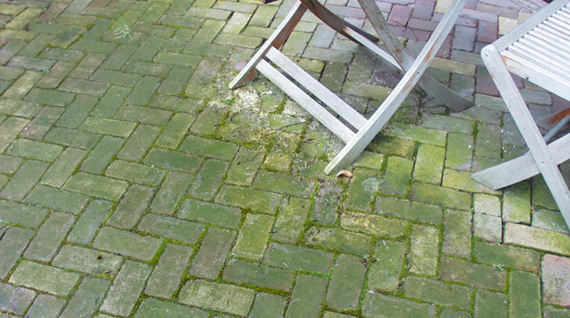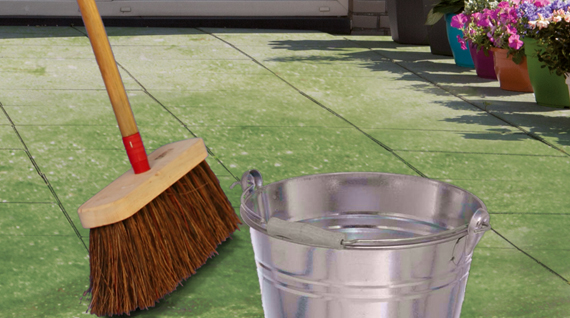How to Get Rid of Green Slime on Patio
Where do green deposits come from?
 Green deposits often occur in moist spots that do not get a lot of sun. Patio or garden tiles in the shade are often affected by it, as well as fencing in shady areas. The deposits form on all types of patios and surfaces, on wood, stone and concrete. Irregular surfaces and soft materials are more affected than hard and straight surfaces, however.
Green deposits often occur in moist spots that do not get a lot of sun. Patio or garden tiles in the shade are often affected by it, as well as fencing in shady areas. The deposits form on all types of patios and surfaces, on wood, stone and concrete. Irregular surfaces and soft materials are more affected than hard and straight surfaces, however.
The seasons also play a big role. Green deposits are often more stubborn during fall and winter because there is less sunlight and more rain. Therefore, spring is the best time for cleaning paving slabs; and of course you want to be able to enjoy a beautiful and clean patio on nice sunny days.
Tips for preventing green deposits
Unfortunately, you will never be able to prevent green deposits completely due to our rainy climate and the changing seasons. You can however make some choices when paving or installing a patio that will reduce the risk of algae and moss forming on your patio. For example, you can make your patio slightly sloping and provide good drainage so little or no water will remain on your patio. This way the moss and algae have less chance of attaching to the patio.
So few green deposits will form or it will take them longer to form. The materials you choose also plays a role. Some materials are more prone to green deposits than others. So you might want to get hardwood when installing fencing or well-coated tiles. Please consult an expert for advice.
Tips for removing green deposits
Three DIY solutions for removing green deposits
In addition to specially developed products, there are lots of DIY solutions for cleaning patio slabs on various blogs and websites. Note: these methods do not guarantee success:
1. A high-pressure cleaner
Especially during spring and summer, many people choose a high-pressure cleaner for cleaning paving slabs. Unfortunately, there are two major drawbacks. First of all, you will blow the grout out of the patio tiles which might cause the tiles to displace. Secondly, the high-pressure cleaner might damage the tiles so the structure of the tile becomes more porous, which will cause the algae and moss to penetrate deeper into the tile. And this will cost you even more time and energy the next time you have to clean the patio.
 2.Chlorine or white vinegar
2.Chlorine or white vinegar
An often used patio cleaning solution is chlorine or white vinegar. Chlorine is however harmful to plants etc., which makes it unsuitable for outdoor use. White vinegar is more natural than chlorine, but can be harmful to some plants too, especially to grass and herbs. Be careful when using white vinegar, because the acid can damage natural stone with a high lime content. This is not suitable for every patio, so we advise you test it out in an inconspicuous spot first.
3. Mixture of soft soap, soda and hot water
A mixture of soft soap, soda and hot water is especially efficient for removing green deposits from wood surfaces. However, scrubbing your patio table with a hard brush is time-consuming, plus you will only see the result after rinsing the furniture, so you might have missed some spots and have to start all over again. This is not a problem with the HG product range!
If it does not work the way you expected it to? Then try the HG products especially developed for cleaning concrete patios and removing green deposits.
HG is thé patio cleaning solution for easy and effective removal of green deposits
HG has a special products for the removal of green deposits; HG algae and mould remover. This is a convenient product for fast and effective removal of green deposits from walls, fencing, doors and pergolas. The HG algae and mould remover ready to use in 5 litre variant (only available during spring) is perfect for spring cleaning in the garden. We also have HG patio cleaner. This is a concentrated cleaner, sufficient for up to 200 metres of tiles, patios, garden paths, walls and rooftops.
Do you have a good tip for removing green deposits? Let us know!
How to Get Rid of Green Slime on Patio
Source: https://hg.eu/uk/tips/how-to-remove-green-deposits